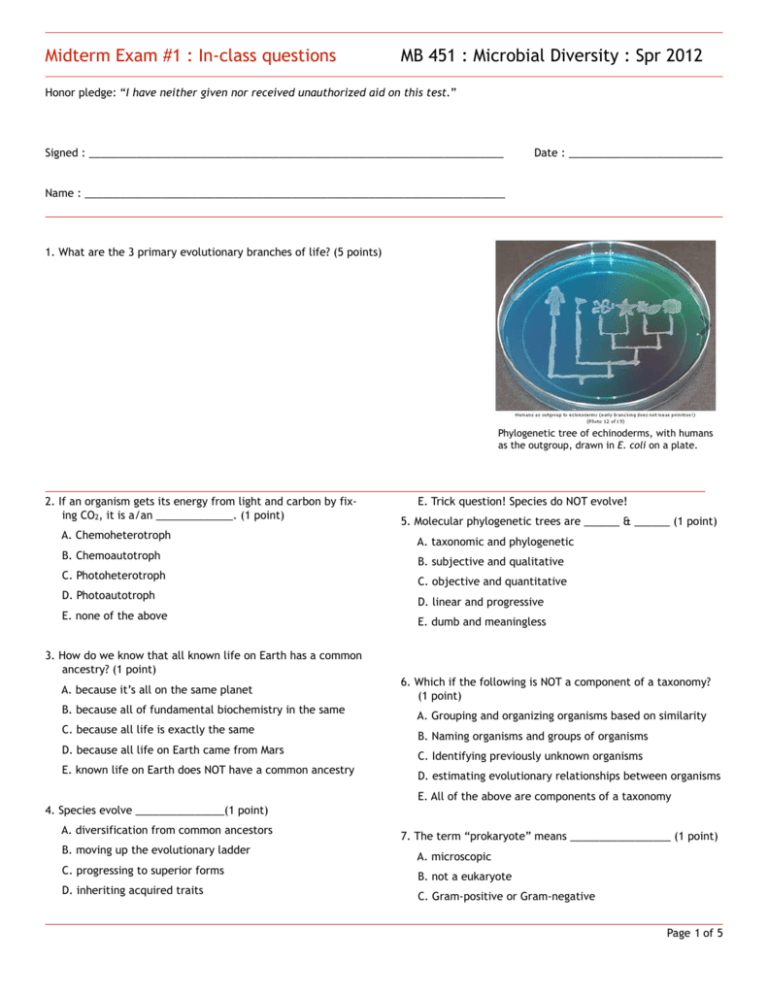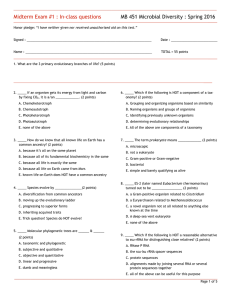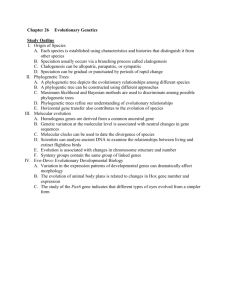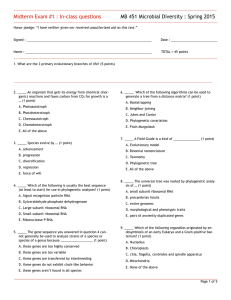Midterm Exam #1 : In-class questions MB 451 : Microbial Diversity
advertisement

Midterm Exam #1 : In-class questions MB 451 : Microbial Diversity : Spr 2012 Honor pledge: “I have neither given nor received unauthorized aid on this test.” Signed : ______________________________________________________________________ Date : __________________________ Name : _______________________________________________________________________ 1. What are the 3 primary evolutionary branches of life? (5 points) Phylogenetic tree of echinoderms, with humans as the outgroup, drawn in E. coli on a plate. 2. If an organism gets its energy from light and carbon by fixing CO2, it is a/an _____________. (1 point) A. Chemoheterotroph B. Chemoautotroph C. Photoheterotroph D. Photoautotroph E. none of the above 3. How do we know that all known life on Earth has a common ancestry? (1 point) A. because it’s all on the same planet B. because all of fundamental biochemistry in the same C. because all life is exactly the same D. because all life on Earth came from Mars E. known life on Earth does NOT have a common ancestry E. Trick question! Species do NOT evolve! 5. Molecular phylogenetic trees are ______ & ______ (1 point) A. taxonomic and phylogenetic B. subjective and qualitative C. objective and quantitative D. linear and progressive E. dumb and meaningless 6. Which if the following is NOT a component of a taxonomy? (1 point) A. Grouping and organizing organisms based on similarity B. Naming organisms and groups of organisms C. Identifying previously unknown organisms D. estimating evolutionary relationships between organisms E. All of the above are components of a taxonomy 4. Species evolve _______________(1 point) A. diversification from common ancestors B. moving up the evolutionary ladder C. progressing to superior forms D. inheriting acquired traits 7. The term “prokaryote” means _________________ (1 point) A. microscopic B. not a eukaryote C. Gram-positive or Gram-negative Page 1 of 5 D. bacterial E. simple and barely qualifying as alive 8. ES-2 (later named Eubacterium thermomarinus) turned out to be _________________ (1 point) A. a Gram-positive organism related to Clostridium B. a Euryarchaeon related to Methanocaldococcus C. a novel organism not at all related to anything else known at the time D. A deep-sea vent eukaryote 12. Which of the following is and important feature of a useful molecular clock? (1 point) A. Functional constancy B. Comprised of a large number of independently-evolving units C. Large database of sequences and resources D. Not (often) transferred horizontally E. all of the above E. none of the above 9. Which if the following is NOT a reasonable alternative to ssu-rRNA for distinguishing close relatives? (1 point) 13. Which of the following is NOT a major lesson drawn from the “Big tree” of life? (1 point) A. Big eukaryotes represent a small portion of diversity A. RNase P RNA B. Chloroplasbacterial symbiontsts are B. the ssu-lsu rRNA spacer sequence C. Gram-positive/negative are not the major divisions oF Bacteria C. protein sequences D. alignments made by joining several RNA or several protein sequences together D. Mitochondria are bacterial endosymbionts E. protists (unicellular eukaryotes) evolved from Bacteria E. all of the above 14. The “universal tree” was rooted using _________ (1 point) 10. Which if the following is NOT true of “horizontal transfer”? (1 point) A. was more common before the last common ancestor B. occurs between organisms of all phylogenetic distances C. is most frequent between close relatives A. the fossil record B. small-subunit ribosomal RNA C. ancient duplicated genes D. Archaea as the outgroup E. none of the above D. probably is not a major factor in microbial evolution E. All of the above are true 11. What is the purpose of bootstrapping? (1 point) 15. Archaea are most closely-related by ancestry to (i.e. have a common ancestor with) ____________________ (1 point) A. Viruses A. to determine the reliability of branches in a tree B. Bacteria B. to convert a similarity matrix into a distance matrix C. Eukarya C. an algorithm used to generate phylogenetic trees D. mitochondria D. a method of calculate ancestral sequences E. none of the above E. none of the above 16. What is an outgroup, and how is one used in a phylogenetic tree? (5 points) Page 2 of 5 17. Answer the following questions from this tree (1 point each) Pectinatus sottaceto Evolutionary distance 77 71 0.01 substitutions/position 100 100 76 69 Pectinatus haikarae Pectinatus sp. TY 100 100 100 100 66 73 Pectinatus portalensis 100 100 Megamonas rupellensis Megamonas funiformis Megamonas hypermegale 95 100 Selenomonas ruminantium Megasphaera cerevisiae 97 100 Veillonella atypica Sporomusa silvacetica Bacillus subtilis Uppper numbers : Maximum Likelihood bootstrap values (% of 1000 trees, rounded to nearest %) Lower numbers : Weighted neighbor-joining bootstrap values (RDP, % of 100 trees) a. Which sequence is most similar to that of Pectinatus sottaceta? ___________________________________________________ b. What is the outgroup? _______________________________________________________________________________________ c. Which is the most primitive sequence (excluding, perhaps, the outgroup)? __________________________________________ d. Circle the least-reliable branch on the tree and label it “D”. e. What is the approximate evolutionary distance between M. hypermegale and S. ruminantium? _________________________ f. Circle the last common ancestor of the genus Pectinatus and label it “G”. 18. On this 3-Domain molecular phylogenetic tree, circle and label each of the 5 “Kingdoms” in the old-fashioned Whitacker tree (5 points) Page 3 of 5 19. Describe one method OTHER than molecular phylogenetic analysis used to identify microbes. (5 points) 20. What features of the ssu-rRNA make it such a good molecular clock of molecular phylogenetic analysis? (5 points) Page 4 of 5 THOUGHT QUESTION 21. The Europa Explorer, in the year 2035, returns to Earth with a sample of sediment drilled from beneath the icy crust of this moon of Jupiter. Attempts to cultivate anything from the sample fail, but you successfully use small-subunit ribosomal RNAtargeted primers and PCR to obtain 4 reasonable-looking ribosomal RNA sequences (called Europa-1, Europa-2, Europa-3, and Europa-4) from the sample. Below is a tree of these sequences relative to some representative Earth sequences. What can you tell me about how life on Europa and Earth are related, assuming you’re able to show that the sequences are not contamination from Earth, are clean sequences (no sequencing errors) and are properly aligned? (5 points) Homo sapiens (representing Eukarya) Thermococcus celer (representing Archaea) Bacillus subtilis (representing Bacteria) Sequence "Europa-1" Sequence "Europa-2" Sequence "Europa-3" Sequence "Europa-4" Page 5 of 5 Midterm Exam #1 : Take-home questions MB 451 : Microbial Diversity : Spr 2012 Honor pledge: “I have neither given nor received unauthorized aid on this test.” The rules: You are free to use any notes, books, or online material while taking this take-home exam. You are also free to use a calculator and ruler or other drawing material. You are NOT allowed to get (or give) help of any kind from (or to) anybody. If you have questions about the exam, send an email to Dr. Brown at james_brown@ncsu.edu. You MUST turn this completed take-home portion of the exam in with the rest of the exam when you take it, unless you take the exam in the DELTA offices or via remote proctor. Signed : ______________________________________________________________________ Date : __________________________ Name : _______________________________________________________________________ 1. Align the following sequences: (4 points) Oak U A C G A G C C U G G C A Elm U A G G A G C C C U G G U Maple A U G A G C C A U G G C A Pine U A A G A G C C U G A U A 2. Align the following RNAs: (5 points) A A G A U C A - U U A U G U - A C - G C - G A G - C U A U Bob G - C A U Mike U U G • U C - G A G - C A A U John 3. Draw the secondary structures of the Jill and Mary RNAs in this alignment: (5 points) Jill - - G G G G G U A A G C C U - - C C - U A U Mary U C G G C G - - A U A - C G U A C C G - A U Steph - C G G A G A - U U U U C U - - C C G - - - U U U A - U G - C A - U G - C G - C C - G Steph RNA Page 1 of 4 4. Create a similarity matrix from the following alignment, using a 2-parameter model in which transversions count as a full difference (-1.0), and transitions count as half a difference (-0.5): (5 points) Bob G G G G G G G G G G Jim G G G G G G G G G A Sue G G A G G G G G G U Spot G G C G G G U A G C Bubbles G A U G G G A A G - 5. Convert this dendrogram into a phenogram. Notice the bootstrap values! The yeast L30 sequence is the outgroup: (5 points) Page 2 of 4 6. Use the following distance matrix to generate a tree (with branch lengths) using the neighbor-joining method. SHOW ALL OF YOUR WORK! (26 points) A B C D E F A --- --- --- --- --- --- B 0.2 --- --- --- --- --- C 0.4 0.4 --- --- --- --- D 0.7 0.7 0.7 --- --- --- E 0.9 0.9 0.9 0.4 --- --- F 1.0 1.0 1.0 0.9 1.1 --- Page 3 of 4 (CONTINUE YOUR WORK HERE) Page 4 of 4









